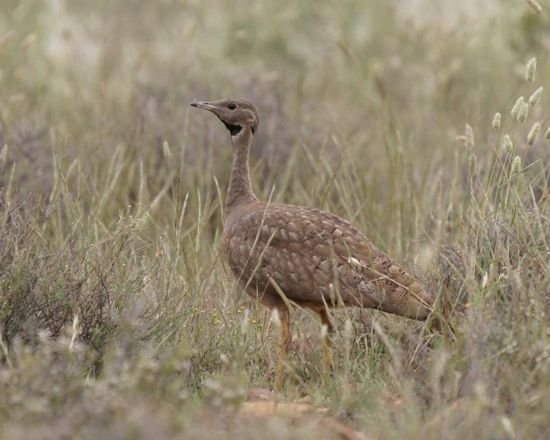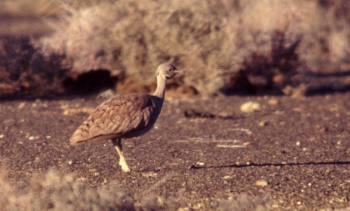(Additional scientific name. Imp sizes. C/right. Basic tidy-up. References updated) |
|||
| (5 intermediate revisions by 2 users not shown) | |||
| Line 1: | Line 1: | ||
| + | [[Image:Karoo Korhaan Martin Hobbs KarooNP Jan2011.jpg|thumb|550px|right|Photo © by {{user|Martin+Hobbs|Martin Hobbs}}<br />Karoo NP, [[South Africa]], January 2011]] | ||
'''Alternative name: Karoo Korhaan''' | '''Alternative name: Karoo Korhaan''' | ||
| − | ;[[:Category:Eupodotis|Eupodotis]] vigorsii | + | |
| − | + | ;[[:Category:Eupodotis|Eupodotis]] vigorsii<br /> | |
| + | ''Heterotetrax vigorsii'' | ||
==Identification== | ==Identification== | ||
| − | Length 56-60 cm; mass 1.6 kg (males), 1.35 kg (females). | + | [[Image:Karoo_Bustard.jpg|thumb|350px|right|Photo © by {{user|balticbird|balticbird}}<br />[[South Africa]], November 2000]] |
| + | Length 56-60 cm (22-23¾ in); mass 1.6 kg (males), 1.35 kg (females). | ||
| − | A grey-brown bustard with a black throat and | + | A grey-brown bustard with a black throat and black patch on the nape.<br /> |
| − | + | In flight, wings show a black-and-buff pattern. | |
| − | + | ====Similar species==== | |
| + | [[Rueppell's Bustard]] is whiter below, paler above, and has a blue-grey neck. | ||
==Distribution== | ==Distribution== | ||
| − | [[Lesotho]], southern [[Namibia]] and [[South Africa]]. | + | [[Africa]]: found in [[Lesotho]], southern [[Namibia]] and [[South Africa]]. |
==Taxonomy== | ==Taxonomy== | ||
| − | ====Subspecies<sup>[[#References|1]]</sup> | + | ====Subspecies==== |
| − | *''E. v. namaqua'' - | + | There are 2 subspecies<sup>[[#References|1]]</sup>: |
| − | *''E. v. vigorsii'' - | + | *''E. v. namaqua'' - southern [[Namibia]] and northwestern [[South Africa]] |
| + | *''E. v. vigorsii'' - southwestern [[South Africa]]. | ||
==Habitat== | ==Habitat== | ||
Mainly stony Karoo shrublands. | Mainly stony Karoo shrublands. | ||
==Behaviour== | ==Behaviour== | ||
| + | ====Diet==== | ||
Usually seen in pairs or small groups. Forages for invertebrates, reptiles, grass and seeds while walking. | Usually seen in pairs or small groups. Forages for invertebrates, reptiles, grass and seeds while walking. | ||
====Breeding==== | ====Breeding==== | ||
| − | Monogamous; cooperative breeding may occur. The nest is a shallow scrape, usually in stony ground with scattered rocks or small shrubs. A single egg is laid June to February. Incubated by the female; after hatching, chick and parents forage together. | + | [[Dictionary_M-O#M|Monogamous]]; cooperative breeding may occur. The nest is a shallow scrape, usually in stony ground with scattered rocks or small shrubs. A single egg is laid June to February. Incubated by the female; after hatching, chick and parents forage together. |
==References== | ==References== | ||
| − | # | + | #{{Ref-Clements6thAug18}}#{{Ref-Hockeyetal05}} |
| + | {{ref}} | ||
==External Links== | ==External Links== | ||
| − | {{GSearch|Eupodotis+vigorsii}} | + | {{GSearch|Eupodotis+vigorsii Use Eupodotis to}} |
| + | <br /> | ||
| + | {{GSearch|Heterotetrax+vigorsii Use Heterotetrax to}} | ||
| + | |||
[[Category:Birds]] [[Category:Eupodotis]] | [[Category:Birds]] [[Category:Eupodotis]] | ||
Revision as of 23:02, 30 January 2019
Alternative name: Karoo Korhaan
- Eupodotis vigorsii
Heterotetrax vigorsii
Identification
Length 56-60 cm (22-23¾ in); mass 1.6 kg (males), 1.35 kg (females).
A grey-brown bustard with a black throat and black patch on the nape.
In flight, wings show a black-and-buff pattern.
Similar species
Rueppell's Bustard is whiter below, paler above, and has a blue-grey neck.
Distribution
Africa: found in Lesotho, southern Namibia and South Africa.
Taxonomy
Subspecies
There are 2 subspecies1:
- E. v. namaqua - southern Namibia and northwestern South Africa
- E. v. vigorsii - southwestern South Africa.
Habitat
Mainly stony Karoo shrublands.
Behaviour
Diet
Usually seen in pairs or small groups. Forages for invertebrates, reptiles, grass and seeds while walking.
Breeding
Monogamous; cooperative breeding may occur. The nest is a shallow scrape, usually in stony ground with scattered rocks or small shrubs. A single egg is laid June to February. Incubated by the female; after hatching, chick and parents forage together.
References
- Clements, J. F., T. S. Schulenberg, M. J. Iliff, D. Roberson, T. A. Fredericks, B. L. Sullivan, and C. L. Wood. 2018. The eBird/Clements checklist of birds of the world: v2018. Downloaded from http://www.birds.cornell.edu/clementschecklist/download/
- Hockey, PAR, WRJ Dean, and PG Ryan, eds. 2005. Roberts' Birds of Southern Africa. 7th ed. Cape Town: John Voelcker Bird Book Fund. ISBN 978-0620340533
Recommended Citation
- BirdForum Opus contributors. (2024) Karoo Bustard. In: BirdForum, the forum for wild birds and birding. Retrieved 25 April 2024 from https://www.birdforum.net/opus/Karoo_Bustard
External Links





